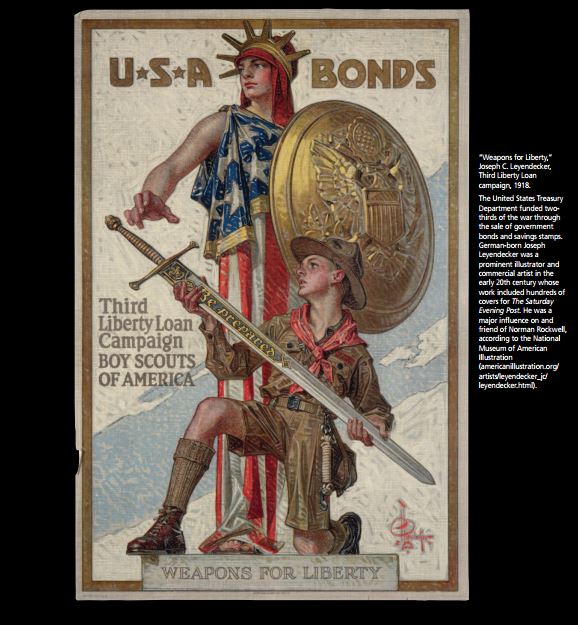by Jessica Jenkins
(c) Connecticut Explored Inc. WINTER 2014/15
Subscribe/Buy the Issue!
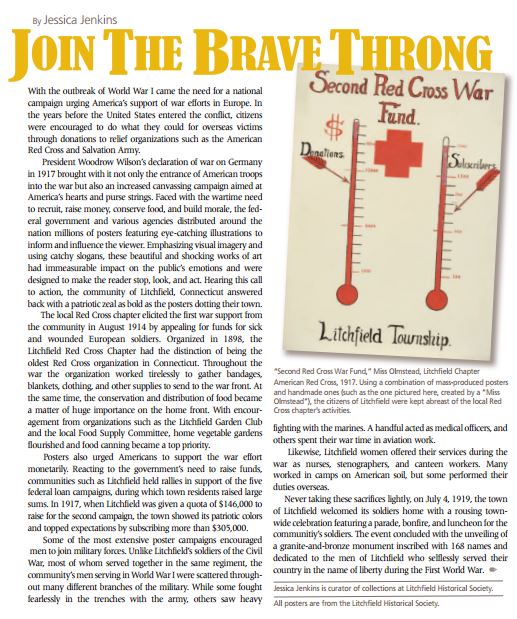 With the outbreak of World War I came the need for a national campaign urging America’s support of war efforts in Europe. In the years before the United States entered the conflict, citizens were encouraged to do what they could for overseas victims through donations to relief organizations such as the American Red Cross and Salvation Army.
With the outbreak of World War I came the need for a national campaign urging America’s support of war efforts in Europe. In the years before the United States entered the conflict, citizens were encouraged to do what they could for overseas victims through donations to relief organizations such as the American Red Cross and Salvation Army.
President Woodrow Wilson’s declaration of war on Germany in 1917 brought with it not only the entrance of American troops into the war but also an increased canvassing campaign aimed at America’s hearts and purse strings. Faced with the wartime need to recruit, raise money, conserve food, and build morale, the federal government and various agencies distributed around the nation millions of posters featuring eye-catching illustrations to inform and influence the viewer. Emphasizing visual imagery and using catchy slogans, these beautiful and shocking works of art had immeasurable impact on the public’s emotions and were designed to make the reader stop, look, and act. Hearing this call to action, the community of Litchfield, Connecticut answered back with a patriotic zeal as bold as the posters dotting their town.
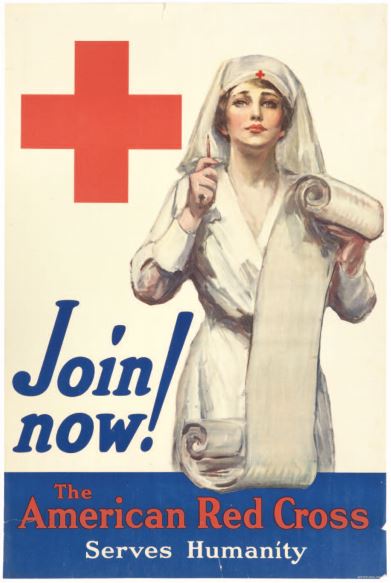
“Join now!,” American Red Cross, 1914-1918, artist unknown. In the World War I era, posters were used on a scale never before seen. In a time before commercial radio and television, these vivid works of art played an important role in communicating with, and influencing, a mass audience.
The local Red Cross chapter elicited the first war support from the community in August 1914 by appealing for funds for sick and wounded European soldiers. Organized in 1898, the Litchfield Red Cross Chapter had the distinction of being the oldest Red Cross organization in Connecticut. Throughout the war the organization worked tirelessly to gather bandages, blankets, clothing, and other supplies to send to the war front. At the same time, the conservation and distribution of food became a matter of huge importance on the home front. With encouragement from organizations such as the Litchfield Garden Club and the local Food Supply Committee, home vegetable gardens flourished and food canning became a top priority.
Posters also urged Americans to support the war effort monetarily. Reacting to the government’s need to raise funds, communities such as Litchfield held rallies in support of the five federal loan campaigns, during which town residents raised large sums. In 1917, when Litchfield was given a quota of $146,000 to raise for the second campaign, the town showed its patriotic colors and topped expectations by subscribing more than $305,000.
Some of the most extensive poster campaigns encouraged men to join military forces. Unlike Litchfield’s soldiers of the Civil War, most of whom served together in the same regiment, the community’s men serving inWorldWarI were scattered throughout many different branches of the military. While some fought fearlessly in the trenches with the army, others saw heavy fighting with the marines. A handful acted as medical officers, and others spent their war time in aviation work.
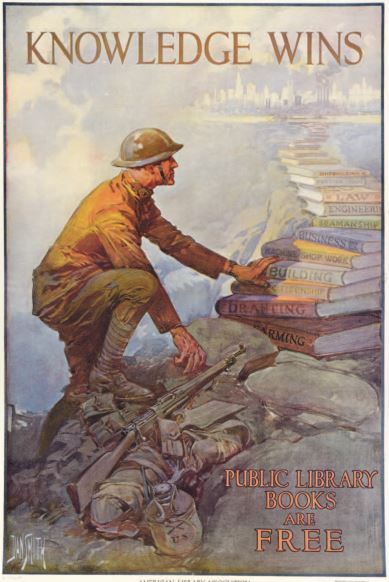
“Knowledge Wins,” Dan Smith, American Library Association, 1914-1918. Throughout the war, United States citizens were asked to supposed Allied forces in Europe through direct donation of goods. In addition to everyday necessities such as clothing and blankets, organizations such as the American Library Association requested books and reading materials for soldiers. Litchfield residents collected books, popular magazines, and newspapers for shipment overseas.
Likewise, Litchfield women offered their services during the war as nurses, stenographers, and canteen workers. Many worked in camps on American soil, but some performed their duties overseas.
Never taking these sacrifices lightly, on July 4, 1919, the town of Litchfield welcomed its soldiers home with a rousing townwide celebration featuring a parade, bonfire, and luncheon forthe communitiy’s soldiers. The event concluded with the unveiling of a granite-and-bronze monument inscribed with 168 names and dedicated to the men of Litchfield who selflessly served their country in the name of liberty during the First World War.
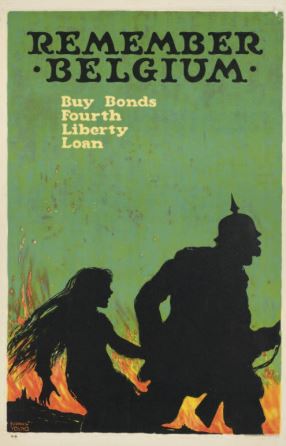
“Knowledge Wins,” Dan Smith, American Library Association, 1914-1918. Throughout the war, United States citizens were asked to supposed Allied forces in Europe through direct donation of goods. In addition to everyday necessities such as clothing and blankets, organizations such as the American Library Association requested books and reading materials for soldiers. Litchfield residents collected books, popular magazines, and newspapers for shipment overseas.
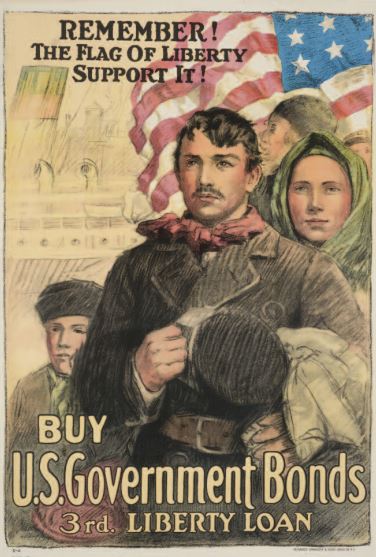
“Remember! The Flag of Liberty,” artist unknown, Third Liberty Loan company, 1918. Posters also relied heavily on patriotic symbols such as the bald eagle, the Statue of Liberty, and the American flag. This poster’s message was that everyone was at some point a new arrival in the United States, and America was a country founded on the ideals of liberty. It also speaks to immigrants and urges them to remember why they came to this country, that they are now Americans, and that they should support their new country and the goals of the Allied nations through buying government bonds.
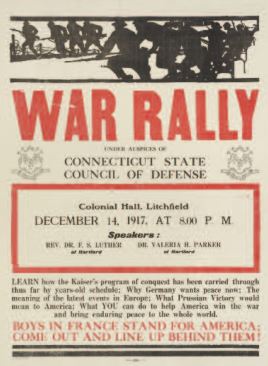
“War Rally,” Connecticut State Council of Defense, 1917. After America’s military entrance into the war in 1917, appeals went out to men to join the armed forces. Because the United States was slow to enter the war, response was initially tepid. Rallies such as the one on December 14, 1917 in Litchfield supported recruitment efforts.
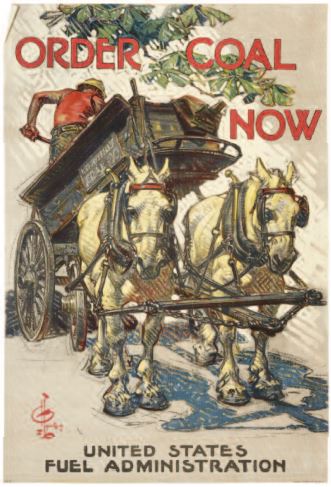
“Order Coal Now,” Joseph C Leyendecker, United States Fuel Administration, 1917. As severe shortages of food, coal, oil and basic goods developed along the war front, posters emphasized the need to ration food and conserve resources at home. Using these supplies sparingly became the mantra of the United States food and fuel administrations and the National War Garden Commission.
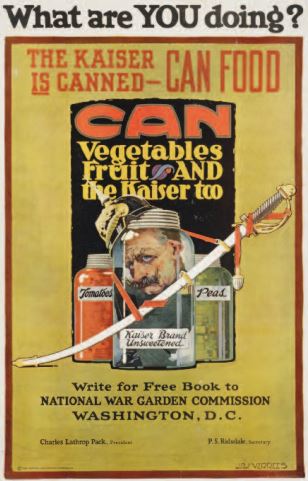
“The Kaiser is Canned” J. Paul Verrees, National War Garden Commission, 1918. During World War I the Litchfield Garden Club frequently gave food-preparation demonstrations, published conservation-minded recipes in the local newspaper, and held sales of fruits and vegetables that might otherwise have been wasted. Featuring everything from comic images of the German kaiser in a canning jar to slogans such as “Food is Ammunition – Don’t Waste It,” these posters reminded citizens that their efforts on the home front also contributed to winning the war.
Explore!
Read more stories about Connecticut in World War I on our TOPICS page.

